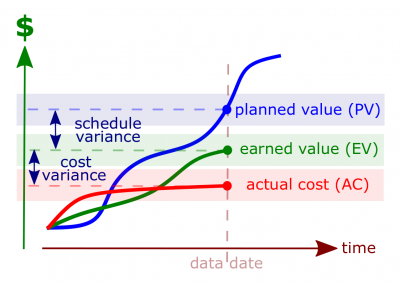Difference between revisions of "Earned value management"
(Created page with "400px|thumb|right|[[Earned value management]]Earned value management (hereinafter, EVM) is a method for integrating scope, schedule, and resources, an...") |
(→Related coursework) |
||
| (2 intermediate revisions by the same user not shown) | |||
| Line 1: | Line 1: | ||
| − | [[File:Evm.png|400px|thumb|right|[[Earned value management]]]][[Earned value management]] (hereinafter, [[EVM]]) is a method for integrating scope, schedule, and resources, and for measuring project performance. It compares the amount of work that was planned with what was actually earned with what was actually spent to determine if cost and schedule performance are as planned. | + | [[File:Evm.png|400px|thumb|right|[[Earned value management]]]][[Earned value management]] (also known by its abbreviation; hereinafter, [[EVM]]) is a method for integrating scope, schedule, and resources, and for measuring project performance. It compares the amount of work that was planned with what was actually earned with what was actually spent to determine if cost and schedule performance are as planned. |
==Key parameters== | ==Key parameters== | ||
| Line 6: | Line 6: | ||
*[[Planned value]] (PV). The physical work scheduled, plus the authorized budget to accomplish the scheduled work. Previously, this was called the budgeted costs for work scheduled (BCWS). | *[[Planned value]] (PV). The physical work scheduled, plus the authorized budget to accomplish the scheduled work. Previously, this was called the budgeted costs for work scheduled (BCWS). | ||
| − | ==Related | + | ==Related lectures== |
| − | *[[ | + | *[[Controlling Quarter]]. |
[[Category: Septem Artes Administrativi]][[Category: Articles]] | [[Category: Septem Artes Administrativi]][[Category: Articles]] | ||
Latest revision as of 12:50, 4 January 2019
Earned value management (also known by its abbreviation; hereinafter, EVM) is a method for integrating scope, schedule, and resources, and for measuring project performance. It compares the amount of work that was planned with what was actually earned with what was actually spent to determine if cost and schedule performance are as planned.
Key parameters
- Earned value (EV). The physical work accomplished plus the authorized budget for this work. The sum of the approved cost estimates (may include overhead allocation) for activities (or portions of activities) completed during a given period (usually project-to-date). In other words, this value is the budgeted cost of work performed for an activity or group of activities.
- Actual cost (AC). The actual amount of money either paid for material or charged as labor, material, or overhead to a work order. In other words, actual costs are total costs incurred that must relate to whatever cost was budgeted within the planned value and earned value (which can sometimes be direct labor hours alone, direct costs alone, or all costs including indirect costs) in accomplishing work during a given time period.
- Planned value (PV). The physical work scheduled, plus the authorized budget to accomplish the scheduled work. Previously, this was called the budgeted costs for work scheduled (BCWS).
